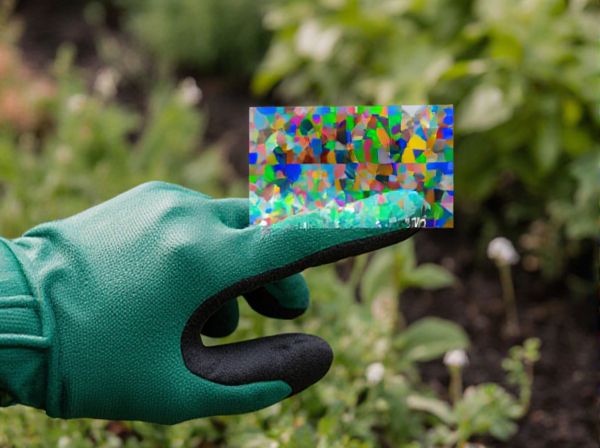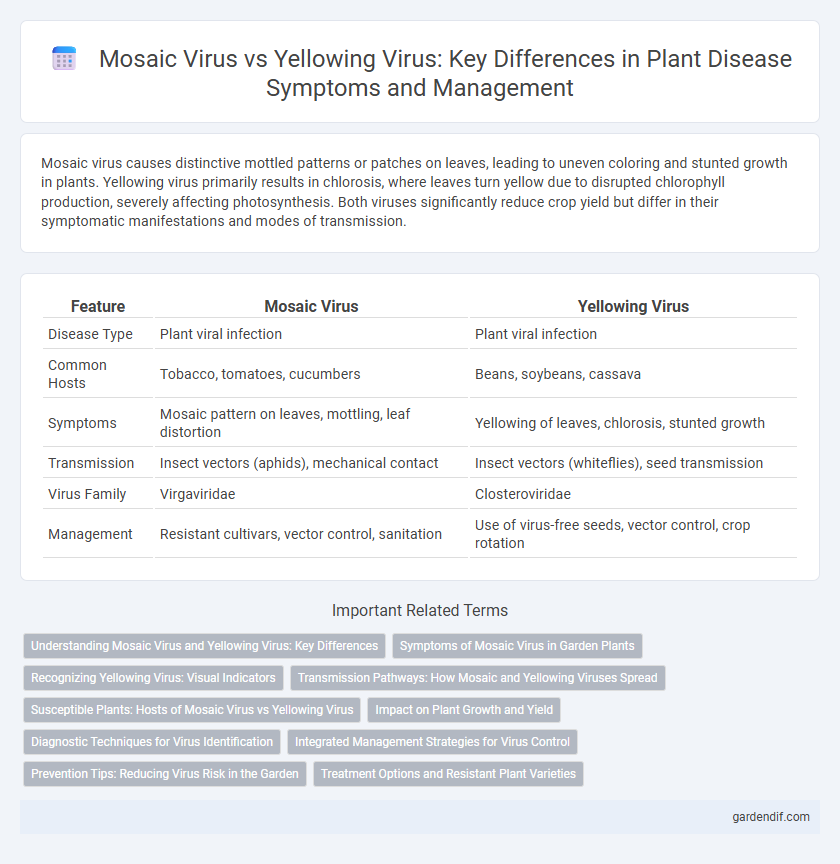
Mosaic virus vs Yellowing virus Illustration
Mosaic virus causes distinctive mottled patterns or patches on leaves, leading to uneven coloring and stunted growth in plants. Yellowing virus primarily results in chlorosis, where leaves turn yellow due to disrupted chlorophyll production, severely affecting photosynthesis. Both viruses significantly reduce crop yield but differ in their symptomatic manifestations and modes of transmission.
Table of Comparison
| Feature | Mosaic Virus | Yellowing Virus |
|---|---|---|
| Disease Type | Plant viral infection | Plant viral infection |
| Common Hosts | Tobacco, tomatoes, cucumbers | Beans, soybeans, cassava |
| Symptoms | Mosaic pattern on leaves, mottling, leaf distortion | Yellowing of leaves, chlorosis, stunted growth |
| Transmission | Insect vectors (aphids), mechanical contact | Insect vectors (whiteflies), seed transmission |
| Virus Family | Virgaviridae | Closteroviridae |
| Management | Resistant cultivars, vector control, sanitation | Use of virus-free seeds, vector control, crop rotation |
Understanding Mosaic Virus and Yellowing Virus: Key Differences
Mosaic virus primarily affects plants by causing mottled patterns of light and dark green on leaves, leading to distorted growth and reduced photosynthesis, whereas Yellowing virus induces chlorosis or yellowing of leaves, significantly impacting plant vitality and yield. Both viruses are transmitted by insect vectors such as aphids but differ in their specific host range and symptom progression. Understanding these distinctions aids in accurate diagnosis and targeted management strategies to mitigate crop losses.
Symptoms of Mosaic Virus in Garden Plants
Mosaic virus causes mottled, irregular patterns of light and dark green on garden plant leaves, often accompanied by leaf curling and distortion. Infected plants may exhibit stunted growth, reduced vigor, and lower fruit or flower yield. These symptoms significantly impact the aesthetic appeal and productivity of affected garden plants.
Recognizing Yellowing Virus: Visual Indicators
Yellowing virus infection is primarily identified by uniform chlorosis, causing entire leaves to turn a pale yellow, in contrast to the patchy mosaic patterns characteristic of mosaic virus. Infected plants exhibit consistent leaf yellowing without the irregular, mottled discoloration typical of mosaic virus, aiding in accurate diagnosis. Observing the distribution and color intensity of the symptoms helps distinguish yellowing virus presence from mosaic virus effects in crops.
Transmission Pathways: How Mosaic and Yellowing Viruses Spread
Mosaic viruses primarily spread through insect vectors such as aphids and whiteflies, which carry the virus while feeding on plant sap, enabling rapid transmission between hosts. Yellowing viruses, including species like the cauliflower mosaic virus, often propagate through soil-borne nematodes or mechanical means such as contaminated tools and plant contact, leading to localized outbreaks. Both viruses can also transmit via infected seeds, contributing to systematic crop infections and posing significant challenges to agricultural management.
Susceptible Plants: Hosts of Mosaic Virus vs Yellowing Virus
Mosaic virus primarily affects solanaceous plants such as tomatoes, peppers, and potatoes, causing mottled patterns on leaves and stunted growth. Yellowing virus targets a broader range of hosts including cucurbits like cucumbers, melons, and squash, leading to yellow discoloration and wilting symptoms. Understanding the specific host range of these viruses is crucial for effective disease management in agricultural systems.
Impact on Plant Growth and Yield
Mosaic virus causes irregular leaf patterns that disrupt photosynthesis, leading to stunted growth and a significant reduction in crop yield. Yellowing virus primarily induces chlorosis, weakening the plant's ability to produce energy and often resulting in lower fruit or grain quality. Both viruses negatively impact plant health but vary in symptom expression and the extent of yield loss across different crop species.
Diagnostic Techniques for Virus Identification
Mosaic virus diagnosis relies on enzyme-linked immunosorbent assay (ELISA) and reverse transcription-polymerase chain reaction (RT-PCR) to detect viral coat protein genes with high specificity. Yellowing virus identification employs serological tests combined with symptom observation and nucleic acid hybridization to confirm viral RNA presence in infected plants. Advanced molecular diagnostics like multiplex RT-PCR enable simultaneous detection of both viruses, enhancing accuracy in mixed infections.
Integrated Management Strategies for Virus Control
Integrated management strategies for controlling Mosaic virus and Yellowing virus emphasize the use of resistant crop varieties alongside vector control measures targeting aphids and whiteflies to reduce virus spread. Implementing crop rotation and removing infected plant residues helps minimize viral inoculum in the field, while timely application of insecticides and biological control agents supports maintaining vector populations below threshold levels. Monitoring and using virus-free seeds combined with proper sanitation practices enhance the overall effectiveness of integrated virus management in agriculture.
Prevention Tips: Reducing Virus Risk in the Garden
Implement crop rotation and remove infected plants promptly to reduce the presence of Mosaic virus and Yellowing virus in the garden. Use virus-resistant plant varieties and maintain proper spacing to prevent the spread of viruses transmitted by aphids and whiteflies. Regularly disinfect gardening tools and control insect vectors with organic insecticides to minimize virus transmission.
Treatment Options and Resistant Plant Varieties
Mosaic virus treatment primarily involves the use of virus-free seeds and resistant plant varieties such as tobacco and cucumber cultivars that exhibit genetic resistance. Yellowing virus management often requires vector control, especially aphid populations, alongside the cultivation of resistant varieties like certain lettuce and pepper strains. Implementing integrated pest management strategies enhances effectiveness in controlling both viruses while minimizing crop losses.
Mosaic virus vs Yellowing virus Infographic

 gardendif.com
gardendif.com